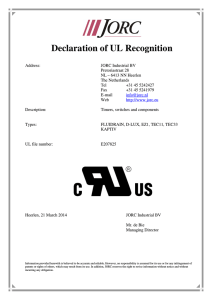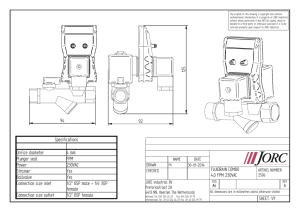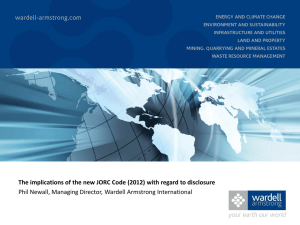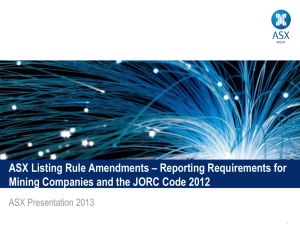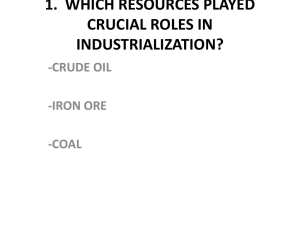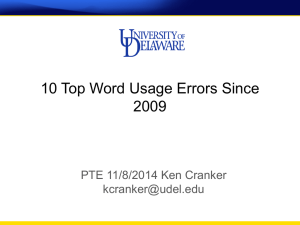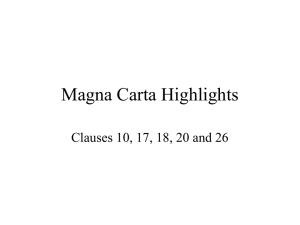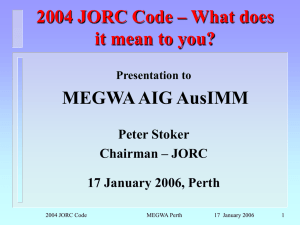Are you Ready for JORC 2012?
advertisement
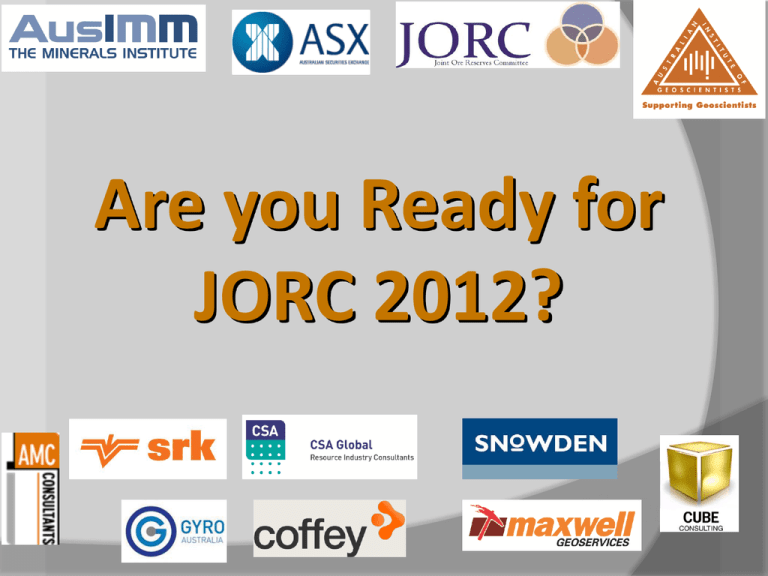
Are you Ready for JORC 2012? Outline Time Presentation 13:00 Welcome (Graham Jeffress, AIG WA) 13:05 Overview and Background to JORC 2012 (Jill Terry JORC) 13:20 What’s changed in JORC 2012 (Chris Cairns JORC) 13:45 Competent Persons (Jacqui Coombes Coombes Capability) 14:15 JORC 2012 – ET & ER (Graham Jeffress AIG WA) 14:30 JORC 2012 – MRE & R (Matt Greentree AIG WA) 14:40 JORC 2012 – Ann Rpts, Etc. (Chris Cairns JORC) 15:00 Tea Break 15:30 ASX listing Rules and JORC 2012 (James Rowe ASX) 16:00 Moderated Panel Session and Question time (Rick Rogerson) 17:15 Sundowner & Informal discussions Contents Introduction New terms Changes to Figure 1 Table 1 Reporting – ‘if not, why not?’ reporting Competent Persons requirements Are you a Competent Person? Exploration Targets Exploration Results – Table 1 Changes and Drill hole information Mineral Resources – Table 1 changes Ore Reserves – Table 1 changes and minimum level of studies Studies definitions Mineral Resources and Ore Reserves annual review Metal equivalents In ground valuations Overview Jillian Terry Why were the JORC Code and ASX Listing Rules updated? Allowed for the inclusion of several Companies Updates since the adoption of the 2004 version of the JORC Code including Metal Equivalents, sampling and Inferred Resource classification In-situ values Historical or foreign estimates ASIC wanted a rule to govern Production Target announcements ASIC wanted annual review of Mineral Resources and Ore Reserves Brought most terms into alignment with the international CRIRSCO reporting guidelines (Committee for Mineral Reserves International Reporting Standards) Wanted to reinforce equal importance of JORC principles of Materiality, Transparency and Competence Why were the JORC Code and ASX Listing Rules updated? Wanted to improve transparency for reporting of Exploration Targets Included a rule on extrapolation clarification for Inferred Resources Wanted to introduce requirements for minimum level of technical studies to support Ore Reserve statements Wanted to change the emphasis of Table reporting from just ‘material’ Table 1 criteria to all Table 1 criteria on an ‘if not, why not?’ basis so investors cannot be mislead by a Public Report remaining silent on a material issue Additional Definitions i.e. studies, material or significant projects, material change Consultation Process Early 2012 review process commenced with request for feedback on ASX Listing Rules and JORC Code exposure documents Public meetings by ASX, JORC, AIG, AusIMM Meetings with industry and MCA 114 written JORC submissions received, 138 ASX written submissions received (two rounds) Co-operative liaison between JORC, ASX and ASIC to produce draft JORC Code and draft ASX Listing Rules – released September 2012 for comment 81 written submission received for JORC Code, written submissions received for ASX Listing Rules Publishing and Transition Period Submissions considered in final drafting of ASX Listing Rules and JORC Code ASX Listing Rules released November 8th 2012 JORC Code released December 20th 2012 Mandatory from Dec 1st 2013 Requirement for a Pre-Feasibility Study to support an Ore Reserve mandatory from Dec 1st 2014 Benefits of High Quality Reporting Accepted and compatible national (and international) public reporting standards will: Provide greater confidence to investors and thereby facilitate capital raising encourage siphoning of scarce risk capital from non-mining sources facilitate investment comparisons between different mineral deposits, and reduce unnecessary effort and cost for debt/equity funding from different sources assist free flow of direct and portfolio investment and therefore reduce cost of capital 17/3/2013 Introduction to JORC 10 What has Changed? What has changed in JORC 2012? Table 1 reporting on an ‘if not, why not?’ basis – Clauses 2, 5, 19, 27, 35 and the introduction of Table 1. Competent Person Attributions – Clause 9 Exploration Targets – Clause 17 Pre-Feasibility required for Ore Reserves – Clause 29 Technical Studies definitions – Clause 37-40 Annual Reporting – Clause 15 Metal Equivalents – Clause 50 In situ values – Clause 51 Additional guidance on reporting in Table 1 ASX Listing Rules have also changed These changes include: Annual reporting of Ore Reserves Parallel requirements with the JORC Code for the reporting of initial or material changes to Exploration Results, Mineral Resources or Ore Reserves Reporting of Production Targets Pre-Feasibility study required to report Ore Reserves – Clause 29 Reporting of historical estimates and foreign estimates Competent Person requirements Reporting Terms of Joint Venture agreements Be careful to check the related requirements of the relevant exchange if reporting for a company listed on an exchange other than ASX! Ignorance is not a defence…… Public Reporting of Exploration Results, Mineral Resources and Ore Reserves must be in compliance with the JORC Code AND must comply with the rules of the relevant securities exchange Listing Rules (ASX Listing Rules & Guidance note 31) or relevant securities exchange Public Reporting that meets ALL requirements New Terms New terms introduced into JORC 2012 Code Significant project “An exploration or mineral development project that has, or could have, a significant influence on the market value or operations of the listed company, and/or has specific prominence in Public Reports and announcements.” (Appendix 1 Generic Terms and Equivalents) New terms introduced into JORC 2012 Code Material change “A material change could be a change in the estimated tonnage or grade or in the classification of the Mineral Resources or Ore Reserves. Whether there has been a material change in relation to a significant project must be considered by taking into account all of the relevant circumstances, including the style of mineralisation. This includes considering whether the change in estimates is likely to have a material effect on the price or value of the company’s securities.” (Guideline to Clause 5) Is the project Material? What is the market capitalisation of the company? Will the disclosure of the information affect the price of the company’s shares? Does the company spend a significant proportion on this project? Does the company earn a significant amount from this project? Will the project be an asset in the medium to long term? Has the company made specific announcements about this project? How prominently does the company promote this project (website, quarterlies, annual reports, presentations, etc)? New terms introduced into JORC 2012 Code ‘if not, why not?’ “means that each item listed in the relevant section of Table 1 must be discussed and if it is not discussed then the Competent Person must explain why it has been omitted from the documentation.” (Guideline to Clause 5) Relationship between Exploration Results, Mineral Resources, & Ore Reserves, Figure 1 of the JORC Code Clause 4 2012 Code — Additional Explanation of Principles “Transparency and Materiality” are guiding principles of the Code, and the Competent Person must provide explanatory comments on material assumptions underlying the declaration of Exploration Results, Mineral Resources or Ore Reserves In particular, […] the benchmark of Materiality is that which includes all aspects relating to the Exploration Results, Mineral Resources or Ore Reserves that an investor (or their advisers) would reasonably expect to see explicit comment on from the Competent Person. The Competent Person must not remain silent on any material aspect for which the presence or absence of comment could affect the public perception or value of the mineral occurrence” This slide contains only extracts from Clause 4, 2012 JORC Code Table 1 Reporting Table 1 structure Section 1 Sampling Techniques and Data Section 2 Reporting of Exploration Results Section 3 Estimation and Reporting of Mineral Resources Section 4 Estimation and Reporting of Ore Reserves Section 5 Estimation and Reporting of Diamonds and Other Gemstones Table 1 2012 Code — Additional Guidance on Reporting Table 1 of the Code now includes additional criteria and amended and/or additional explanation of Table 1 reporting to assist Competent Persons Guidance changes are primarily for reporting of Mineral Resources and Ore Reserves, although there are also additional information requirements related to sampling techniques and the reporting of Exploration Results ‘if not, why not?’ reporting ‘If not, why not’ reporting Improves the Transparency of reporting Intent is to provide clarity to the investor ‘If not why not’ shows that all items have been considered and where the Competent Person concludes the specific item to be of low consequence or is yet to be addressed or resolved. Specific requirements are in Clauses 5, 19, 27, 35, and the introduction to Table 1 The introductory section of Table 1 is significantly expanded to reinforce the 2012 Code’s requirements for how and when Table 1 and ‘if not, why not’ reporting are required. “In the context of complying with the Principles of the Code, comment on the relevant sections of Table 1 should be provided on an ‘if not, why not’ basis within the Competent Person’s documentation and must be provided where required according to the specific requirements of Clauses 19, 27 and 35 for significant projects in the Public Report. This is to ensure that it is clear to the investor whether items have been considered and deemed of low consequence or have yet to be addressed or resolved.” This slide contains only extracts from the Introduction to Table 1, 2012 JORC Code “2. In this edition of the JORC Code, important terms and their definitions are highlighted in bold text. The guidelines are placed after the respective Code clauses using indented italics. They are intended to provide assistance and guidance to readers. They do not form part of the Code, but should be considered persuasive when interpreting the Code. Indented italics are also used for Appendix 1 – ‘Generic Terms and Equivalents’ and Table 1 – ‘Check List of Assessment and Reporting Criteria’ to make it clear that they are also part of the guidelines, and that the latter is not mandatory for reporting purposes.” This statement (in green above), together with all of the examples being negative, was taken by many Competent Persons as an opportunity not to report all material information. “2. In this edition of the JORC Code, important terms and their definitions are highlighted in bold text. The guidelines are placed after the respective Code Clauses using indented italics. Guidelines are not part of the Code, but are intended to provide assistance and guidance to readers and should be considered persuasive when interpreting the Code.” Indented italics are also used for Appendix 1 – ‘Generic Terms and Equivalents’ and Table 1 – ‘Check List of Assessment and Reporting Criteria’ to make it clear that they are also part of the guidelines, and that the latter is not mandatory for reporting purposes. Further guidance on the importance of material information is now included in Clauses 5, 19, 27, 35, and the introduction to Table 1. “Table 1 provides a [reminder] of criteria to be considered by the Competent Person in developing their documentation and in preparing a Public Report. In the context of complying with the principles of the Code, comments relating to the items in the relevant sections of Table 1 should be provided on an ‘if not, why not’ basis within the Competent Person’s documentation.” This slide contains extracts only of Clause 5, 2012 JORC Code. “Additionally, comments related to the relevant sections of Table 1 must be complied with on an ‘if not, why not’ basis within Public Reporting for significant projects […] when reporting Exploration Results, Mineral Resources or Ore Reserves for the first time [or][…] where these items have materially changed from when they were last Publicly Reported. Reporting on an ‘if not, why not’ basis is to ensure that it is clear to an investor whether items have been considered and deemed of low consequence or are not yet addressed or resolved.” This slide contains only extracts from Clause 5, 2012 JORC Code. Emphasis added. Are You Competent? 2004 JORC Code Principles — Competence Bias? A common distortion of Principles from Clause 4, 2004 JORC Code had resulted in: Transparency unclear un ambiguous presentation JORC Materiality selected reasonable information expected Compliant Reports? Competence Based on work by Competent Person Competent Person’s Consent [For] Public reporting of Exploration Results, Mineral Resources and Ore Reserves for significant projects for the first time or when there is a material change, the company must include the following: Competent Person’s name and the name of their employer Any possible conflicts of interest for the Competent Persons? Public report is based on documentation compiled by the Competent Person. The Competent Person(s) must have given prior written consent in regards to the “form and context” in which the public report appears; and Competent Person’s Consent Public reports also need … A statement of written consent from the Competent Person A Competent Person Consent Form is available from the JORC website. The onus is on the company to obtain approval, but the Competent Person should encourage observation of this requirement There are recent examples where this has not happened! Written consent may be requested by ASX and placed on the Company Announcements Platform. JORC 2012 - Additional Provisions for Competent Persons Conflicts of interest • Identify and disclose potential conflicts of interest by the Competent Person or a related party, such as: • shares or options held in the Company, or • performance-related bonus payments linked to the reporting of Exploration Results, Mineral Resources or Ore Reserves Previously Reported Results Where the Competent Person(s) has previously given consent [a] report can refer back to the original report. However, the company must confirm that: “It is not aware of any new information or data that materially affects the information included in the relevant market announcement.” and “In the case of estimates of Mineral Resources or Ore Reserves, the company confirms that all material assumptions and technical parameters underpinning the estimates in the relevant market announcement continue to apply and have not materially changed.” Clause 9 of the JORC Code, 2012 Edition What is a Competent Person? (Clause 11) “A ‘Competent Person’ is a minerals industry professional who is a Member or Fellow of AusIMM, or of AIG, or of a ‘Recognised Professional Organisation’ (RPO) A Competent Person must have a minimum of 5 years relevant experience in the style of mineralisation or type of deposit under consideration and in the activity which that person is undertaking. If the Competent Person is preparing documentation on Exploration Results, the relevant experience must be in exploration. If the Competent Person is estimating, or supervising the estimation of Mineral Resources, the relevant experience must be in the estimation, assessment and evaluation of Mineral Resources. If the Competent Person is estimating, or supervising the estimation of Ore Reserves, the relevant experience must be in the estimation, assessment, evaluation and economic extraction of Ore Reserves.” Competent Person Self Test : 1. Do I belong to an appropriate professional organisation? AusIMM, AIG, or a Recognised Professional Organisation (RPO) 2. Do I have the minimum relevant experience? 5 years experience relevant to the commodity & style of mineralisation & the activity The key qualifier in the definition of a Competent Person is the word ‘relevant’. It is not always necessary for a person to have five years experience in every type of deposit in order to act as a Competent Person. Am I satisfied that I could face my peers and demonstrate competence in the commodity, type of deposit, and situation under consideration? If doubt exists, either seek an opinion from appropriately experienced colleagues or decline to act as a Competent Person 3. Jacqui Coombes Reporting of Exploration Targets Exploration Target – now defined (Clause 17) “An Exploration Target is a statement […] of the […] potential of a mineral deposit in a defined geological setting where the statement or estimate […] relates to mineralisation for which there has been insufficient exploration to estimate a Mineral Resource.” Clause 17 of the JORC Code, 2012 Edition Exploration Target – now defined (Clause 17) Exploration Target is defined in Clause 17 of the 2012 JORC Code which also explains how that terminology may be used within a Public Report. The clause emphasises the importance of ensuring that a reported Exploration Target cannot be misconstrued or misrepresented as a Mineral Resource or Ore Reserve, and that all disclosures of an Exploration Target must clarify whether the target is based on actual results or a proposed exploration programme. Exploration Target – now defined (Clause 17) Clause 17 of the 2012 JORC Code is a significant expansion and further development of Clause 18 of the 2004 JORC Code. The 2012 Clause 17 definition of Exploration Target is identical to the CRIRSCO definition. Clause 17 also includes additional further explanation of how Exploration Targets should be reported in Public Reports. Exploration Target – now defined (Clause 17) Key points to remember: Must only report target tonnes and grade (quality) as RANGES Must report whether the target is based on actual results or on proposed [work] Report all exploration conducted to date Must include the warning statement within the same paragraph as the first reference to the Exploration Target Exploration Target – now defined (Clause 17) Key points to remember (con’t): Exploration Targets cannot be used in a ‘headline’ or highlights section Must include details of [work] designed to test the validity of the Exploration Target and a timeframe within which those activities are expected to be completed Maps, cross-sections or graphs must be accompanied with explanatory text The Public Report including an Exploration Target must be accompanied by a Competent Person’s statement taking responsibility for the form and context in which the Exploration Target appears. Reporting of Exploration Results Exploration Results (Clause 19) “Clear diagrams and maps designed to represent the geological context must be included in the report. These must include, but not be limited to a plan view of drill hole collar locations and appropriate sectional views.” This slide contains only extracts from Clause 19, 2012 JORC Code Exploration Results (Clause 19) “As required under Clause 4 and 5, the Competent Person must not ‘remain silent on any issue for which the presence or absence of comment could impact the public perception or value of the mineral occurrence’. For significant projects the reporting of all criteria in sections 1 and 2 of Table 1 on an ‘if not, why not basis’ is required, preferably as an appendix to the Public Report. Additional disclosure is particularly important where inadequate or uncertain data affect the reliability of, or confidence in, a statement of Exploration Results; for example, poor sample recovery, poor repeatability of assay or laboratory results, etc.” This slide contains only extracts from Clause 19, 2012 JORC Code Exploration Results (ASX Listing Rule 5 and Guidance Note 31) ASX Listing Rule 5.7 An entity publicly reporting in relation to a material mining project, either: (a) exploration results for the first time; or (b) any new exploration results, must include all of the following information in a market announcement and give it to ASX for release to the market. This slide contains extracts only of the ASX Listing Rules and Guidance Note 31 Exploration Results (ASX Listing Rule 5 and Guidance Note 31 – cont’d) 5.7.1 As an appendix to the market announcement, a separate report providing all information that is material to understanding the exploration results, in relation to each of the criteria in section 1 (sampling techniques and data) and section 2 (reporting of exploration results) of Table 1 in Appendix 5A (JORC Code). An entity that determines that one or more of those criteria is not material for this purpose must identify each such criterion and explain why it has determined that it is not material to understanding the exploration results. This slide contains extracts only of the ASX Listing Rules and Guidance Note 31 Exploration Results (ASX Listing Rule 5 and Guidance Note 31 – con’t) 5.7.2 As an appendix to the market announcement, a separate table setting out the following information for material drillholes unless the entity determines that the information is not material: • easting and northing of the drill-hole collar • elevation or RL of the drill-hole collar • dip and azimuth of the hole • down hole width and depth • end of hole This slide contains extracts only of Rule 5.5 of the ASX Listing Rules Guidance Note 31 Reporting of Minerals Resources Additional Requirements for Reporting Mineral Resources (Clause 27) When reporting a Mineral Resource for a significant project for the first time, or when those estimates have materially changed from when they were last reported, the following must be included: A brief summary of the information in relevant sections of Table 1 must be provided, or, if a particular criterion is not relevant or material, a disclosure that it is not relevant or material and a brief explanation of why this is the case must be provided. Additional Requirements for Reporting Mineral Resources (Clause 27 – cont’d) “For a significant project, when Mineral Resource estimates are first Publicly Reported or when a material change occurs (including classification changes), there is an increased need for transparent discussion of the basis for the new Mineral Resource estimate in order that investors are appropriately informed of the basis for the changes. As noted in Clauses 4 and 5 the benchmark of Materiality is that which an investor or their advisors would reasonably expect to see explicit comment on from the Competent Person, thus the reporting of all relevant criteria in Table 1 on an ‘if not, why not’ basis is required.” “The Technical summary based against Table 1 criteria should be presented as an appendix to the Public Report.” Note: This guidance relates directly to ASX Listing Rule requirements. Reporting of Ore Reserves Minimum of Pre-Feasibility Study for Reporting Ore Reserves (Clause 29 & 37) “An ‘Ore Reserve’ is the economically mineable part of a Measured and / or Indicated Mineral Resource. It includes diluting materials and allowances for losses, which may occur when the material is mined or extracted and is defined by studies at Pre-Feasibility or Feasibility level as appropriate that include application of Modifying Factors” Clause 29 “However attention is drawn to the requirement for a Pre-Feasibility Study or a Feasibility Study to have been completed for the Public Reporting of an Ore Reserve in Clause 29. An Ore Reserve must not be reported based on the completion of a Scoping Study.” Clause 37 This slide contains extracts only of Clauses 29 and 37, 2012 JORC Code Additional Requirements for Reporting Ore Reserves (Clause 35) “In a Public Report of an Ore Reserve estimate for a significant project for the first time, or when those estimates have materially changed from when they were last reported, a brief summary of the information in relevant sections of Table 1 must be provided or, if a particular criterion is not relevant or material, a disclosure that it is not relevant or material and a brief explanation of why this is the case must be provided. For a significant project, when Ore Reserve estimates are first Publicly Reported or when a material change occurs (including classification changes), there is an increased need for transparent discussion of the basis for the new Ore Reserve estimate in order that investors are appropriately informed of the basis for the changes.” This slide contains extracts only of Clause 35, 2012 JORC Code Additional Requirements for Reporting Ore Reserves (Clause 35 – cont’d) “As noted in Clauses 4 and 5 the benchmark of Materiality is that which an investor or their advisers would reasonably expect to see explicit comment on from the Competent Person, thus the reporting of all criteria in Table 1 on an ‘if not, why not’ basis is required.” “The Technical summary based against Table 1 criteria should be presented as an appendix to the Public Report. Where there are as yet unresolved issues potentially impacting the reliability of, or confidence in, a statement of Ore Reserves (for example, limited geotechnical information, complex orebody metallurgy, uncertainty in the permitting process, etc.) those unresolved issues should also be reported.” This slide contains extracts only of Clause 35, 2012 JORC Code Additional Requirements for Reporting Ore Reserves (Clause 35 – cont’d) “If there is doubt about what should be reported, it is better to err on the side of providing too much information rather than too little. Uncertainties in any of the criteria listed in Table 1 that could lead to under-or over- statement of Ore Reserves should be disclosed.” This slide contains extracts only of Clause 35, 2012 JORC Code Technical Studies Definitions in 2012 Code (Clauses 37 to 40) Clause 37 describes what technical and economic studies are, and their application under the JORC Code. Scoping Study – Clause 38 Pre-Feasibility Study – Clause 39 Feasibility Study – Clause 40 This was in response to the requirement for a Pre-Feasibility Study to be conducted as part of estimating an Ore Reserve for inclusion in a Public Report. These definitions are identical to those in the CRIRSCO standard definitions, and will eventually be included in all the CRIRSCO standards and codes. Annual Reporting of Mineral Resources and Ore Reserves Annual Reporting of Mineral Resources and Ore Reserves (Clause 15) “Companies must review and publically report their Mineral Resources and Ore Reserves at least annually.” Clause 14 - 2004 JORC Code “Companies must review and publically report their Mineral Resources and Ore Reserves annually. The annual review date must be nominated by the Company in its Public Reports of Mineral Resources and Ore Reserves and the effective date of each Mineral Resources and Ore Reserves statement must be shown. The Company must discuss any material changes to previously reported Mineral Resources and Ore Reserves at the time of publishing updated Mineral Resources and Ore Reserves.” Clause 15 – JORC Code 2012 Annual Reporting of Mineral Resources and Ore Reserves (Clause 15 – cont’d) What does it all mean for reporting Mineral Resources and Ore Reserves? Companies must nominate their date of review Does not need to be June 30 or January 1 but must be an annual review date – don’t even think about February 29th!! Each reference in a Public Report must state the ‘effective date’ The annual review must discuss any material changes from the previously reported Mineral Resources and / or Ore Reserves Other Code changes — Metal Equivalents & In Situ Values Reporting Metal Equivalents (Clause 50) New requirements for Public Reporting of Exploration Results, Mineral Resources or Ore Reserves in terms of metal equivalents. If a single equivalent grade for one major metal is reported, the details for all material factors contributing to the net value [are needed] Reporting Metal Equivalents (Clause 50) All material factors include: Individual grades for all metals Assumed commodity prices for all metals (where the actual prices used are commercially sensitive, the company must disclose sufficient information, [though] perhaps in narrative rather than numerical form) Assumed metallurgical recoveries for all metals and discussion of the basis on which the assumed recoveries are derived (metallurgical test work, detailed mineralogy, similar deposits, etc.) A clear statement that all the elements included in the metal equivalents calculation have a reasonable potential to be recovered and sold Calculation formula used Reporting of In Situ or ‘In Ground’ Values (Clause 51) Prohibition on the publication of in situ or ‘in ground’ financial values in a Public Report. Such values are inconsistent with the requirements of the Code, as they do not take account of the Modifying Factors and are incompatible with the Code’s reporting terminology (as set out in Figure 1, and throughout the Code). The use of such financial values has little or no relationship to economic viability, value or potential returns to investors. This new clause is based on information previously included in ASX Companies Update 03/08, previously prepared jointly by ASX and JORC. Tea Break Are you Ready for JORC 2012? ASX Listing Rules and Guidance Note 31 ASX Listing Rules linkage 17/3/2013 Introduction to JORC 72 ASX Presentation James Rowe State Manager ASX Listings Compliance (Perth) Panel discussion Rick Rogerson – Moderator Panel Deborah Lord, SRK Consulting Jason Harris, Cube Jeff Elliott, CSA Global Richard Sulway, Snowden John Hearne , Coffey Dean Carville , AMC Some Questions ? Where can CPs find examples and advice about best practice and who can CPs call for advice? How do we deal with 2004 MRE in a 2012 world? What is the difference between an aspiration & an Exploration Target? Does at ET have an implication of being eventually economic? Must there be on ground work done to define an ET? How do people deal with reporting preliminary economic information on ET or Inferred Res? Isn’t there a catch-22 between the Continuous Disclosure provisions and the prohibition on reporting economic modelling based on Inferred Resources or Exploration Targets? How does VALMIN and JORC coexist? How can we improve the ‘policing’ of the JORC code, will 2012 help? Thank You Remember to visit the JORC website www.jorc.org for: Copies of the 2012 JORC Code Downloadable Table 1 template Links to ASX Listing Rules, FAQs, & Guidance Note 31 Other guidance material
